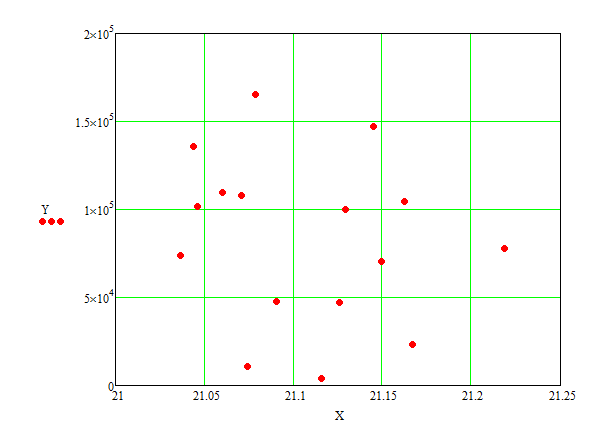Community Tip - You can subscribe to a forum, label or individual post and receive email notifications when someone posts a new topic or reply. Learn more! X
- Subscribe to RSS Feed
- Mark Topic as New
- Mark Topic as Read
- Float this Topic for Current User
- Bookmark
- Subscribe
- Mute
- Printer Friendly Page
Finding curve
- Mark as New
- Bookmark
- Subscribe
- Mute
- Subscribe to RSS Feed
- Permalink
- Notify Moderator
Finding curve
I want to approximate the experimental data by a curve as shown below on screenshot. I tried to use inverse probability density for the normal distribution, but without success. Are there any ideas in this regard (which equation can describe the data or maybe I need to create several sections/parts of the curve)?
Initial data:

The approximating curve must have the following form:

Or this form:

Solved! Go to Solution.
- Labels:
-
Statistics_Analysis
Accepted Solutions
- Mark as New
- Bookmark
- Subscribe
- Mute
- Subscribe to RSS Feed
- Permalink
- Notify Moderator
Do you mean putting the Y data on a log10 scale?
- Mark as New
- Bookmark
- Subscribe
- Mute
- Subscribe to RSS Feed
- Permalink
- Notify Moderator
Here's one possibility. The data has so much error you are unlikely to get a curve that looks like what you want though. The fitted parameters will be pretty much meaningless too.
- Mark as New
- Bookmark
- Subscribe
- Mute
- Subscribe to RSS Feed
- Permalink
- Notify Moderator
See please Figs 12.9, 12.12 & 12.13 here
- Mark as New
- Bookmark
- Subscribe
- Mute
- Subscribe to RSS Feed
- Permalink
- Notify Moderator
Richard,
Thank you. Whether and there are any ideas how to correct your model on a case of transition to a decimal logarithm?
- Mark as New
- Bookmark
- Subscribe
- Mute
- Subscribe to RSS Feed
- Permalink
- Notify Moderator
- Mark as New
- Bookmark
- Subscribe
- Mute
- Subscribe to RSS Feed
- Permalink
- Notify Moderator
Thanks!
- Mark as New
- Bookmark
- Subscribe
- Mute
- Subscribe to RSS Feed
- Permalink
- Notify Moderator
Richard,
Could you please explain what technique you used to set the approximating function and selection of the coefficients/constants in the equation?
- Mark as New
- Bookmark
- Subscribe
- Mute
- Subscribe to RSS Feed
- Permalink
- Notify Moderator
I'm not sure what you mean. You started with dnorm, which has two parameters. One controls the shift along the x-axis (D1) and one controls the width (D2). It seemed clear to me that two more were needed to make the curve pass through the data: one to scale the y-axis and one to offset on the y-axis. So I added D3 and D4.
With the logarithmic y-scale I forced D2 to a positive value (using |D2|) because genfit was trying to make it negative, causing the fit to fail.
I chose the guess values by temporarily changing F(x):=f(x,D) to F(x):=f(x,guess) and adjusting the guess values until the curve roughly passed through the data. Then I changed it back.
Does that answer your question?
- Mark as New
- Bookmark
- Subscribe
- Mute
- Subscribe to RSS Feed
- Permalink
- Notify Moderator
Ok. I see.
- Mark as New
- Bookmark
- Subscribe
- Mute
- Subscribe to RSS Feed
- Permalink
- Notify Moderator
Does the term "shotgun pattern" apply? 😉
- Mark as New
- Bookmark
- Subscribe
- Mute
- Subscribe to RSS Feed
- Permalink
- Notify Moderator
Absolutely ![]() .
.





